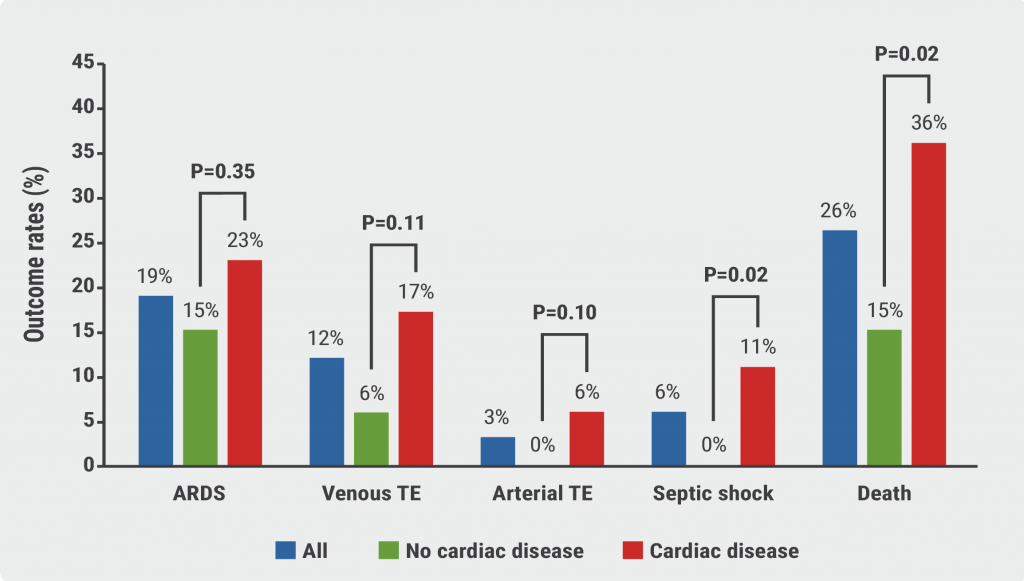“Experimental and pre-clinical data points to the fact that IL-17A has a role in the pathogenesis of GCA,” Prof. Jens Thiel (Medical University Graz, Austria) stated [1]. This was the rationale to perform the phase 2 TitAIN trial (EudraCT 2018-002610-12), the first randomised, parallel-group, double-blind, placebo-controlled, multicentre trial of secukinumab in patients with GCA. Included participants had new-onset or relapsing GCA and were naïve to biological therapy. They were randomised to secukinumab 300 mg (n=27) or placebo (n=25), initially administered weekly for 5 weeks and then every 4 weeks through week 48 (last dose), in combination with a 26-week prednisolone taper regimen starting from baseline. Primary endpoint was the proportion of patients in sustained remission until week 28.
At week 28, 70.1% (95% CI 51.6–84.9) of participants receiving secukinumab were in sustained remission compared with 20.3% (95% CI 12.4–30) of those given placebo. Prof. Thiel pointed out that participants treated with secukinumab had a 9.3 times higher chance of being in sustained remission at week 28 compared with placebo. The positive effect was maintained until week 53. At this time, 59.3% (95% CI 38.8–77.6) in the secukinumab group were still in remission compared with only 8.0% (95% CI 1.0–26.0) of those in the placebo group. The median time to flare among patients in the placebo group was 197 days (95% CI 101–280); the median time to flare in the secukinumab group was not reached because there were very few flare events through week 52. Cumulative prednisolone doses were similar in both groups at week 28, but the cumulative dose was higher in the placebo group by week 52 (3,376 mg vs 2,841 mg).
The safety profile of secukinumab was consistent with previous reports. There was 1 fatal serious adverse event in the secukinumab group and 1 in the placebo group. The event in the secukinumab group was regarded as unrelated to the treatment.
“If you look back some years, nobody would have expected that IL-17 inhibition could play a role in GCA, but you can learn a lot from basic immunology. Our hypothesis was that IL-17 has a major effect on the different immune cells in GCA and our data tell us this is really the case,” Prof. Thiel concluded. A phase 3 trial is now being performed to determine whether these preliminary findings can be replicated and then adding anti IL-17A therapy to the GCA therapeutic armamentarium.
Other interesting options in the pipeline
In a GCA mouse model, arterial wall lesional T cells were effectively suppressed through inhibition of Januse kinase (JAK)3 and JAK1. This was the rationale for a pilot study (NCT03026504), presented as a poster during the meeting, in which 14 patients with GCA were treated with the JAK1/JAK2 inhibitor baricitinib (4 mg daily) for 52 weeks [2]. The agent was well tolerated, and only 1 patient relapsed during the study. The remaining 13 patients achieved steroid discontinuation and remained in disease remission until the end of the study. Another JAK1/JAK2 inhibitor, upadacitinib, is also under investigation in the SELECT-GCA trial (NCT03725202), enrolling a desired 420 participants in a multicentre, randomised, double-blind, placebo-controlled study over 4 years. So, the future looks bright for patients with GCA [3].
- Venhoff N, et al. Secukinumab in giant cell arteritis: a randomized, parallel-group, double-blind, placebo-controlled, multicenter phase 2 trial. Abstract L19, ACR Convergence 2021, 03–10 November.
- Koster M, et al. Baricitinib in relapsing giant cell arteritis: a prospective open-label single-institution study. Abstract 1396, ACR Convergence 2021, 03–10 November.
- Harrington R, et al. Biologics. 2021 Jan 6;15:17-29.
Copyright ©2022 Medicom Medical Publishers
Posted on
Previous Article
« Cycling JAK inhibitors shows similar effectiveness to switching to a bDMARD in difficult-to-treat RA Next Article
Vaccine booster improves immune response in patients treated with rituximab »
« Cycling JAK inhibitors shows similar effectiveness to switching to a bDMARD in difficult-to-treat RA Next Article
Vaccine booster improves immune response in patients treated with rituximab »
Table of Contents: ACR 2021
Featured articles
Late-Breaking Abstracts
Vaccine booster improves immune response in patients treated with rituximab
IL-17 inhibition showing efficacy in GCA in phase 2 trials
Spotlight on Rheumatoid Arthritis
Cycling JAK inhibitors shows similar effectiveness to switching to a bDMARD in difficult-to-treat RA
Pre-existing heart failure affects safety of hydroxychloroquine in RA patients
Patients with RA-associated interstitial lung disease benefit from antifibrotic agent
Ultra-low dosing of rituximab in RA is a viable treatment option
Kidney disease and hydroxychloroquine dose are risk factors for developing retinopathy
More pros than cons for the use of statins in RA
Psoriatic Arthritis: Novel Developments
Selective IL-23 inhibition: a new option in active PsA
Ustekinumab: highly efficacious in PSA independent of methotrexate
COVID-19: What You Need to Know
Vaccinated rheumatic patients carry increased risk for COVID-19 breakthrough infections
B-cell depleting medication increases COVID-19 breakthrough infection outcome risk
COVID-19 mRNA vaccine safe and tolerable in adults with autoimmune disease
SLE Treatment: What Is New
Iberdomide: an upcoming new treatment possibility in lupus erythematosus
Sequential rituximab after belimumab does not improve disease control in SLE
Lupus patients less protected by COVID-19 vaccine
Late-Breaking Posters
Promising results in uric acid-lowering in gout patients with a new xanthine oxidase inhibitor
Laboratory and clinical signs 24h after hospitalisation predict MIS-C in children
Related Articles

May 26, 2022
Vaccine protection wanes faster for cancer patients
© 2024 Medicom Medical Publishers. All rights reserved. Terms and Conditions | Privacy Policy
HEAD OFFICE
Laarderhoogtweg 25
1101 EB Amsterdam
The Netherlands
T: +31 85 4012 560
E: publishers@medicom-publishers.com

